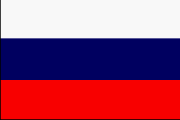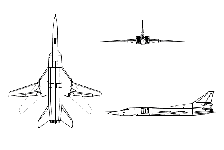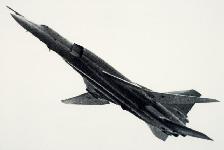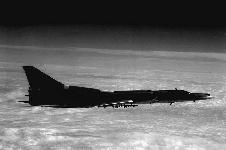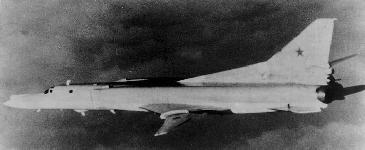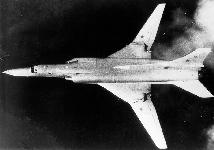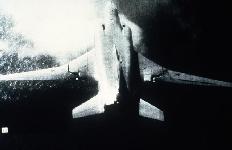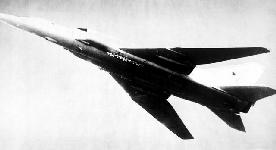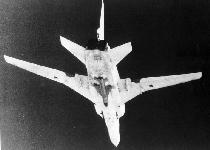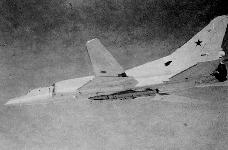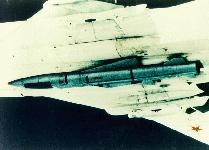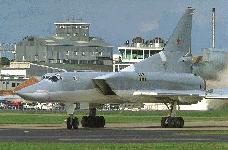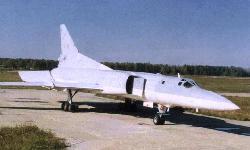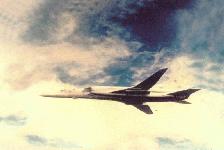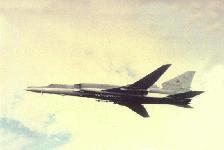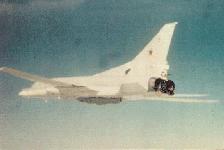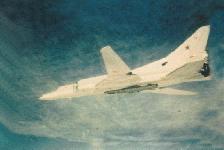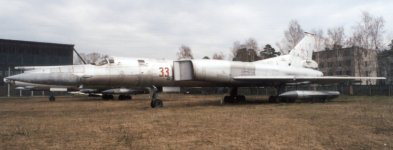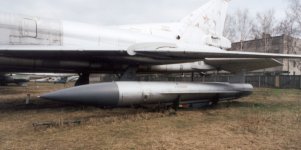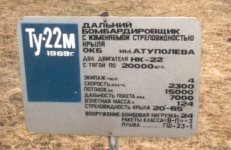Tu-22M BACKFIRE (TUPOLEV)
The BACKFIRE is a long-range aircraft capable of performing nuclear strike, conventional attack, antiship, and reconnaissance missions. Its low-level penetration features make it a much more survivable system than its predecessors. Carrying either bombs or AS-4/KITCHEN air-to-surface missiles, it is a versatile strike aircraft, believed to be intended for theater attack in Europe and Asia but also potentially capable of intercontinental missions against the United States. The BACKFIRE can be equipped with probes to permit inflight refueling, which would further increase its range and flexibility.
After designing the TU-22, the Tupolev design bureau started working on a new bomber that was based on the TU-22. Initially Tupolev considered modifying the TU-22 by changing the angle of the swept wings and equipping it with more powerful engines. However after developing the design "106" and various analysis, the design did not meet the flight characteristic requirements. Tupolev also developed the design "125". The aircraft was supposed have two VK-6 engines, a range of 4500-4800 km and an operating speed of up to 2500 km/h. The design provided for the use of titanium alloys and advanced electronic systems.
In 1962, the "125" design was examined by the Government but rejected, as the T-4 aircraft designed by KB Sukhoi was accepted. As an alternative to the T-4 aircraft, KB Tupolev developed the "145" airplane which was a modification of the TU-22. This airplane represented a multi-mode supersonic bomber which was capable of flying at subsonic speed at small altitudes and at supersonic speed to overcome air defenses. The range at subsonic speed was supposed to be 6000-7000 km. The wings are swept-back and had a variable geometry to meet the speed and range requirements. The aircraft should carry Kh-22 air-to-surface missiles which had already been deployed on other aircraft. After activities on the T-4 bombers were halted, KB Tupolev was officially charged with building the "145" aircraft in 1967. The new bomber was intended to have a maximum speed of 2300 km/h and a range of 7000 km without refueling. It received the designation TU-22M.
The Tu-22M designation was used by the Soviets during SALT-2 arms control negotiations, creating the impression that the Backfire-A aircraft was a modification of the Tu-22 Blinder. This designation was adopted by the US State and Defense Departments, although some contended that the designation was deliberately deceptive, and intended to hide the performace of the Backfire. Other sources suggest the "deception" was internal, because this made it easier to get budgets approved. According to some sources, the Backfire-B/C production variants were believed to be designated Tu-26 by Russia, although this is disputed by many sources. At Tupolev the aircraft was designated the AM.
Many of the development steps in manufacturing the AM were unique in their time. Special attention was given to the construction of the variable sweep wing - the basis of the whole project. The mid-mounted wings are variable, swept-back, and tapered with curved tips and a wide wing root. Two turbofan engines are mounted in the body, with large rectangular air intakes and dual exhausts. The fuselage is long and slender with a solid, pointed nose and stepped cockpit. The body is rectangular from the air intakes to the exhausts. The tail fin is swept-back and tapered with a square tip. The flats are mid-mounted on the body, swept-back, and tapered with blunt tips. The wing consists of a center section and two outer panels that have five fixed positions with respect to the leading edge sweep. The two-spar centre section has a rear web and bearing skin panel. The outer wings are secured to the centre section with the aid of hinged joints. The high-lift devices include three-section slats and double-slotted flaps on the outer wings (extension angle: 23~ for takeoff and 40~ for landing) and a tilting flap on the centre section.
- Backfire A - TU-22MO -- The first TU-22M received the designation TU-22MO but was only produced in small quantities due to inadequate performance. In February 1973 two TY-22Mo bombers were transferred to a training center.
- Backfire A - TU-22M -- The first prototype of the TU-22M was finished in July 1971. The test phase of the few TU-22M lasted four years, after which they were deployed with Soviet Naval Aviation.
- Backfire B - TU-22M2 -- The first large-scale modification of the TU-22M was the TU-22M2, which conducted first flight tests in 1973. It was equipped with NK-22 engines, had range of 5100 km and a maximum speed of 1800 km/h. It carried up to three Kh-22 air-to-surface missiles. The aircraft did not have an automatic terrain-following system but was nevertheless capable of low-level flight to overcome air defenses. In 1976, the TU-22M2 was deployed with the air force and naval airforce. A total of 211 TU-22M2 aircraft were produced at the plant Nr.23 in Kazan between 1973 and 1983. Soon after series production of the TU-22M2 began, the aircraft received new NK-23 engines to increase speed and range. The NK-23 is a booster version of the NK-22 engine, which did not achieve the expected goals.
- Backfire B - TU-22M2Ye -- Some aircraft were outfitted with new NK-25 engines and an sophisticated new flight-control system. They were designated as TU-22M2Ye, but did not achieve improved flight characteristics.
- Backfire C - TU-22M3 -- During subsequent upgrades the nose was lengthened, the air intakes changed and the maximum angle of the swept-variable geometry wings increased up to 65 degrees. The aircraft received the designation TU-22M3 and carried out its' first flight test on 20 June 1977. The TU-22M3 began operational evaluation in the late 1970s, and in 1983 it was introduced into the active inventory. Cleared of some of the shortcomings of its predecessor this aircraft soon proved its worth in service with long-range and naval aviation units. The range of the bomber was increased to 6800 km, the maximum speed up to 2300 kms/h and the payload was twice that of the Tu-22M2. The bomber is equipped with a maximum of three Kh-22 cruise missiles or up to ten Kh-15 (AS-16) short-range missiles. It can also carry nuclear bombs. In 1985 the TU-22M3 conducted high-peed flight tests at low altitude that demonstrated the capability of countering air defenses.
- Backfire - TU-22MR -- In 1985, the long-range reconnaissance aircraft TU-22MR entered service.
- Backfire - TU-22ME -- Improvement of flight and fighting characteristics continued, and in 1990 the TU-22ME was developed.
When the new supersonic bomber appeared at the Kazan aircraft plant in 1969, it validated the long-held Air Force prediction of a new Soviet bomber. In 1971, the aircraft, now designated the Backfire, was noted in aerial refueling from a tanker near the test center of Ramenskoye, just east of Moscow. The mission of the bomber, peripheral attack or intercontinental attack, became one of the most fiercely contested intelligence debates of the Cold War. The key variable was the estimate of the range of the aircraft. A series of competitive analyses to determine the range produced divergent results and failed to end the debate.
Tupolev claimed a radius of action of only 2,200km for the early model Backfires. The US Defense Intelligence Agency (DIA) initially had estimated the Backfire's unrefuelled combat radius at approximately 5,000 km, sufficient to pose a strategic threat to the United States, while the Central Intelligence Agency (CIA) estimate was about 3,700 km. subsequently the DIA estimate was reduced to about 4,000 km, and the CIA estimate to 3,360-3,960 km.
The dominant view of the American intelligence community was that the Backfire was a peripheral attack weapon and would not play a significant role in a strategic air attack on the United States. This view was based on the Backfire's limited payload, modest self-defense capabilities, and anticipated difficulty in staging the aircraft from northern Siberian bases. The US lacked hard evidence that the Backfires ever rehearsed intercontinental strike missions. The Air Force estimate of range and intent argued that the Backfire could be used for intercontinental attack -- even if the aircraft flew one-way missions for an attack on the United States.
Athough a significant number of Backfire bombers were targeted on US naval vessels, the Backfire was the focus of a hotly contested arms control debate that focused on failure to limit further modernization and production of Backfire fleet. Although the Backfire bomber had an exclusively theater mission, under certain circumstances, it could be used to strike targets in the United States. Arms control opponents contended that the United States left open a loophole the Soviets would eventually exploit. The United States stated that as it can be refueled in flight -- allowing it to reach the United States -- the Backfire was an intercontinental bomber and should be subject to the same restrictions as other strategic bombers. The Soviets consistently maintained that the Backfire was not a strategic bomber because of its non-intercontinental range.
During the SALT II process, the United States negotiating team obtained a statement from then-Soviet Premier Brezhnev that the Backfire's refueling capabilities would not be upgraded to allow them to function as intercontinental strategic bombers, and that the Soviets would only build 30 of these bombers per year. When the SALT-2 treaty was signed in 1979, the Soviets informed the USA that it would not equip the TU-22M bombers with air refueling devices. SALT II was not ratified, though subsequently the air refueling system was removed from all TU-22M.
According to press reports in the late 1980s, a defector stated that the Backfire was regularly exercised at intercontinental range, that this intercontinental range was greater than the Bison's, that the Backfire had a screw-in type refueling probe, that this screw-in refueling probe was stockpiled for every Backfire at all bomber bases, and that the Soviets had an active program of camouflage, concealment, and deception to mislead the West about the intercontinental range capability of the Backfire.
According to press reports, the Soviets tested long range ALCM's on the Backfire in the late 1970's. The CIA in 1987 made the unclassified judgment that it would consider Backfires as ALCM-carriers in the event of confirmed Soviet breakout from SALT II. The CIA's rationale for their judgment was that in the absence of SALT II constraints, the Soviets would use the ALCM-capable Backfire to attack the United States.
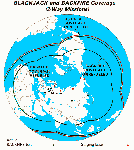 The Defense Department publication Soviet Military Power published in March, 1983, stated on page 26 that: "The Soviets are developing at least one long-range air-launched cruise missile (ALCM) with a range of some 3,000 kilometers. Carried by the Backfire, the Blackjack, and possibly the Bear, it would provide the Soviets with greatly improved capabilities for low-level and standoff attack in both theater and intercontinental operations."DIA stated in its unclassified February 1990 Soviet Force Structure Summary publication on page 6 that: `The Backfire has an intercontinental strike capability when equipped with a refueling probe.'
The Defense Department publication Soviet Military Power published in March, 1983, stated on page 26 that: "The Soviets are developing at least one long-range air-launched cruise missile (ALCM) with a range of some 3,000 kilometers. Carried by the Backfire, the Blackjack, and possibly the Bear, it would provide the Soviets with greatly improved capabilities for low-level and standoff attack in both theater and intercontinental operations."DIA stated in its unclassified February 1990 Soviet Force Structure Summary publication on page 6 that: `The Backfire has an intercontinental strike capability when equipped with a refueling probe.'
The US proposed to the Soviets that they sign a politically binding declaration outside of START, which would commit them to: (1) not give the Backfire an intercontinental capability by air-to-air refueling or by any other means; (2) deploy no more than 400 Backfire; and (3) include all Backfire -- including naval Backfire--in the Conventional Forces in Europe [CFE] aircraft limits.
On 31 July 1991 the Soviet side declared as part of the START I negotiations that it would not give the Tu-22M airplane the capability of operating at intercontinental distances in any manner, including by in-flight refueling. The Soviet Union stated that it would not have more than 300 Tu-22M airplanes at any one time, not including naval Tu-22M airplanes, and that the number of naval Tu-22M airplanes would not exceed 200. In view of the fact that there must be no constraints in the START Treaty on arms that are not strategic offensive arms, Tu-22M airplanes would thus not be subjected to that Treaty.During the 1980s Backfires were used for conventional bombing raids in Afghanistan, particularly during the last year of direct Soviet involvement. By 1991 it was reported that, due to a shortage of spare parts, some Backfire units had mission-capable rates of 30-40%. During the 1990s many Backfires were transferred from Long Range Aviation forces to Russian naval units in north Russia. However, by the late 1990s, at least 125 were in service with Long-Range Aviation and another 47 were in service with in Naval Aviation.
In December 1999 it was announced that India would lease four Tu-22M3 Backfire bombers, with the aircraft slated arrive in India as early as June 2000. India's Tu-142 and Il-38 aircraft will be upgraded in Russia. An initial batch of five aircraft will be sent to Russia and during this period the Tu-22M3s will undertake a maritime role armed with AS-20 Kayak anti-ship missiles. India is making substantial purchases of the Novator 3M-54 Alfa missile to equip Kilo class submarines and its new frigates. It is believed that an air-launched variant will be purchased to arm the Tu-142s currently in service and the six to eight additional aircraft being sought by the Navy. If an air-launched version of the Alfa is procured, it is anticipated that India's Tu-22M3s will eventually be equipped to fire them.
Specifications |
||||
| Soviet Designation | TU-22M0 | TU-22M1 | TU-22M2 | TU-22M3 |
| US-Designation | Backfire A | Backfire A | Backfire B | Backfire C |
| Design Bureau | OKB-156 Tupolev | |||
| Manufacturer | Plant Nr. 22 Kazan | |||
| Approved | ||||
| Development began | 1967 | |||
| First Flight | 8/30/1969 | 6/1/1971 | 1972 | 6/20/1977 |
| Series production | 1971 | 1973-1983 | From 1977 on | |
| Date deployed | Not deployed | 1976 | 1976 | 1981 |
| Crew | 4 men | |||
| Unit cost | ||||
| Power Plant | Two NK-144-22 turbojet engines | Two NK-22 turbojet engines | Two NK-22 turbojet engines | Two NK-25 turbojet engines |
| Thrust | 20.000kg each | 22.000kg each | 22.000kg each | 25.000kg each |
| Length | 41.5m | 41.5m | 41.46m | 42.46m |
| Height | 11.05m | |||
| Wingspan (minimum) | 22.75m | 25m | 25m | 23.3m |
| Wingspan (maximum) | 31.6m | 34.28 m | 34.28 m | 34.28 m |
| Wing surface | 183.5sqm (at minimum sweep), 175.8sqm (at maximum sweep) | |||
| Speed (cruise) | 900km/h | 900km/h | ||
| Speed (maximum) | 1.530km/h | 1.660km/h | 1.800km/h | 2.300km/h |
| Ceiling | 13.000m | 14.000m | ||
| Weight (empty) | 53,500kg | |||
| Fuel weight | ||||
| Maximum take-off weight | 121.000kg | 122.000kg | 122.000kg | 126.400kg |
| Normal load | 6.000kg | |||
| Maximum load | 24.000kg | |||
| Operational Range [Russian Sources] | 4,140km | 5,000km | 5,100km | 7,000km |
| Combat Radius unrefueld [US estimates] | 4,000-5,000 km [DIA] 3,360-3,960 km [CIA] | |||
| Armament: | Two GSH-23 (23mm) guns | |||
Sources and Resources
- Russian Strategic Nuclear Weapons, Pavel Podvig, ed., IzdAT, Moscow, 1998, 492 pp. (in Russian). Authors: Oleg Bukharin, Timur Kadyshev, Eugene Miasnikov, Pavel Podvig, Igor Sutiagin, Maxim Tarasenko, Boris Zhelesov
- Tupolev Tu-22M 'Backfire' @ Encyclopedia of World Military Aircraft
- Tu-22M by Alex V.Mryakin
- Tu-22M "Backfire" at Virtual Aircraft Museum
- Tu-22M at Watson's Mititary Page
- Tu-26, Tupolev 'Backfire' @ Gustin's Military
- Tu-22M, Tupolev 'Backfire' @ Gustin's Military
- Collection of Tu-22M3 and other photos by Andrej Pechenkin



